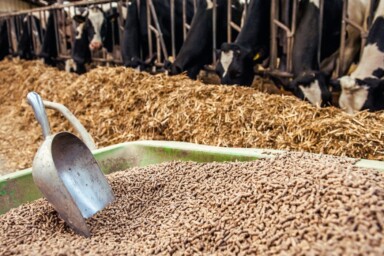The trend in UK dairying is for farms to get bigger over time. More cows, bigger sheds, bigger parlours, bigger tractors and so on. It’s a rational response to the difficulty of producing milk for less than 30p per litre. Dairy farms are increasing in size to benefit from economies of scale and are capitalising upon the land and infrastructure that is becoming available as others get out of dairy or go bankrupt. Where I live in Pembrokeshire, there used to be dozens of dairies, according to locals, and now there are just a handful. The smaller farms are generally the ones getting out of dairying. How can anyone run a profitable small dairy when farmers are paid as little as 12p per litre?
According to the historian Joan Thirsk, throughout agricultural history, when a crisis presents itself, different farmers take different approaches. Many will do more of the same, hoping to be the last survivors, some will diversify or switch to a different type of farming, but each time a small minority of farmers will innovate and do something radically different. Most of these innovations won’t stand the test of time, but some do, and these push farming in a new direction.
Dairying itself is an example of this. Thirsk notes that until the Industrial Revolution, cities didn’t generally enjoy fresh milk, at least not as much as they do today. Transportation times were too long, so the only fresh milk available to cities was from farms on their fringes. The railways transformed this, and farms that found themselves close to a rail network (through the luck of geography) were able to send their milk to the expanding cities of the Industrial Revolution. As a result, these farms grew in size from the ‘micro dairies’ they once were. Farms far away from industrial centres, such as those in the south west of England, continued to do what they always did and produced cheese – a product that is shelf-stable and could withstand longer journeys. As a result, the region is still a stronghold of English cheeses, such as the world-renowned Cheddar.
Today, the dairy industry is again in crisis. The number of dairy farms in the UK continues to plummet, due to the price pressures placed on them. When someone can buy 4 pints of milk for little more than £1 — it’s hard to see how dairy farming can continue to be economically viable in this country. As people switch to plant-based ‘mylks’, there could be a real challenge ahead for British dairy farmers.
While most farmers struggle to get a fair price, our farm, Mountain Hall, can’t produce enough milk to sell from our micro dairy, and that’s at £2 a litre. We have a waiting list that’s probably as big as we can ever hope to supply, and it continues to grow every month, even though we do zero advertising. It’s not yet providing us with a full livelihood, but it is now making a small profit — and that’s without any agricultural subsidy. We’re still growing slowly in size, but with a little investment this year, next year it should be able to provide a full-time livelihood for my wife and I, and it’s already providing a part-time income for two additional farm workers.
While £2 a litre for milk is understandably expensive for people on a low-income, our customers are paying for the price of a production system that has fewer externalities – costs that are not accounted for directly within the production system that society pays for indirectly through taxes, public spending and other ‘hidden’ costs.
From chatting to many people about dairy farming, I believe there’s a growing collective sense that the public feels dairy farms are becoming too big. In response to this, there is an increasing number of micro and small dairies, like ours, that have growing demand for their milk. There’s Stroud Microdairy, Old Hall Farm and Calf at Foot Dairy in Norfolk, Taw River Dairy in Devon, Smiling Tree Farm and Babbinswood in Shropshire, Plaw Hatch Farm in Sussex, to name a few. Micro dairying isn’t easy, but then farming never was. It is tapping into a local demand for milk with a face on it from people who care.
People want to know more about where their food comes from – that’s well-evidenced now. They want connection, identity and trust. They want to know the names of the cows, the diet they eat and how the calves are treated. Most of the new micro dairy start-ups are rearing calves ‘at foot’ suckling on their mother — in other words they’re not weaned until later in life, anywhere between three and nine months. These farms all rely primarily on pasture for the cow’s feed, with some dairies supplementing with grain.
If dairy farmers want to attract the customers of the future, they’re going to have to consider what customers want and take change on-board. Millennials, in particular, are turning towards alternative ‘mylks’, because of concern about the mainstream practices of dairying. Of course, there’ll always be a market for cheap milk, but realistically how will farms in the UK continue to produce milk at the price demanded by the commodity milk market? It’s a race to the bottom that few will win.
It’s not just micro dairies innovating with keeping calves with their mother. There’s The Ethical Dairy in Scotland, an excellent organic farm that transitioned from the usual system of weaning calves at birth, to suckling them until five months of age, with 120 milking cows. They’re proving that with investment and commitment, it’s possible to make it work on a larger scale. How many medium-scale dairies are surviving in the modern milk market, yet alone succeeding? And it’s not just the cows and calves that are doing better, it’s the staff too. Their main milker is working half the hours he once worked at a larger, more intensive farm. I’ve seen young dairy farmers burnt out in their mid-20s due to the extreme demands placed upon them. Is that sustainable? For new entrants to farming micro dairying offers a more accessible option to those who’d like to get into dairying, but don’t come from a farming background. Crucially, it offers the farmer a direct connection with their customer, giving them control of their business.
I appreciate that most farmers will never want to change their system so radically, and some are happy doing what they do now, and if it works for them then great. I’m not trying to persuade anyone to change. But one thing we know for sure is that dairy is struggling, and change is amongst us. Farms will adapt in all the ways that farms always have. Some will get bigger, some will get out, but maybe some will get smaller and thrive.







